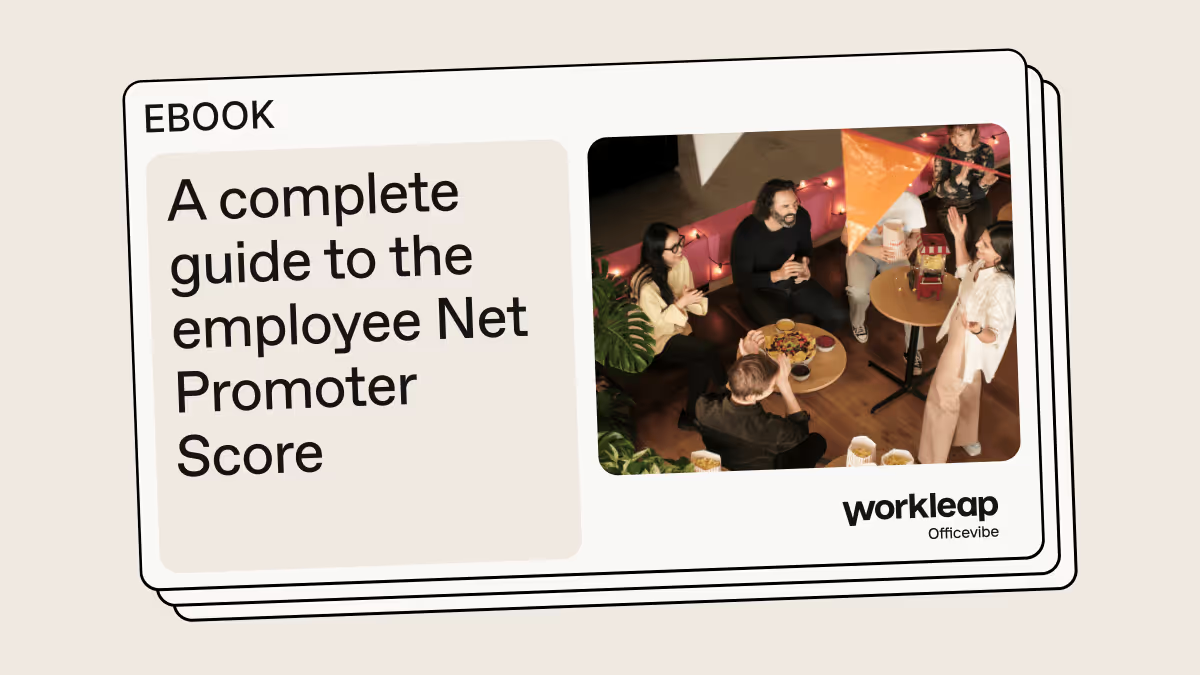A complete guide to the employee Net Promoter Score (eNPS)

Calculate where you stand with your people and build a winning employer brand.
%20(1).png)
When measuring employee engagement and satisfaction, the employee Net Promoter Score, or eNPS, is the metric you should use to get actionable insights.
Salary is no longer the leading determining factor for employee loyalty and productivity. Employees want to take on new challenges, learn new skills, and know that their organization values their time and input.
Collaboration, flexibility, and the company’s culture also determine employee experience (EX) and retention rates.
Considering all these factors to measure employee engagement can be challenging. However, the eNPS provides a user-friendly engagement tool you can use to analyze employee satisfaction and identify areas for continuous improvement.
This guide will take an in-depth look at the employee Net Promoter Score, its scoring methodology, and how one single question can be a powerful springboard to measuring and improving engagement within your organization.
Measuring employee engagement: What is the eNPS?
The employee Net Promoter Score (eNPS) is a simple way to track loyalty and pride for your organization. And it’s an important part of the Engagement Metrics in Officevibe. It measures employees’ willingness to recommend your organization as a good place to work, and whether they’re engaged and enthusiastic about their work. It evolved from the original customer-focused Net Promoter System.
{emphasize}
The history of employee Net Promoter Score (eNPS)
It started in 2003 when Fred Reichheld, a partner at Bain & Company (founders of the Net Promoter System), created a new way to measure how well an organization treats the people whose lives it affects — or how well it generates relationships worthy of loyalty. He called that metric the Net Promoter Score or NPS®.
He didn’t keep the methodology to himself. He shared it so anyone could apply it, and organizations developed and expanded it over time. It evolved to extend its use beyond customers, applying it to help build employee engagement and commitment. The new methods had broadened impact, not just on measuring customer loyalty but now also on transforming their organizations.
{emphasize}
The NPS question asks: “On a scale of 0 to 10, how likely are you to recommend our organization’s products or services to a friend or colleague?”
While the eNPS question asks: “On a scale of 0 to 10, how likely are you to recommend our organization as a place to work to others?”

The employee Net Promoter Score respondent categories
Depending on their answers, your employee Net Promoter Score survey respondents will fall into three categories:
- Promoters: Engaged employees with a score of 9 or 10
- Neutrals: Employees with an eNPS score of 7 or 8
- Detractors: Employees with a score ranging from 0 to 6
Promoters
Promoters are satisfied employees who contribute positively to promoting company image and growth. The company culture resonates with these employees and inspires them to deliver top-tier work.
Unfortunately, many companies don’t focus on these employees when evaluating employee Net Promoter Score surveys.
Promoters’ feedback can provide valuable insights into what positively contributes to their employee experience, and companies should leverage this information to retain talented employees and increase productivity.
Neutrals
Neutral employees are generally satisfied with their work environment but remain open to offers from other companies.
These employees are not likely to recommend the organization as a workplace. Still, they won’t speak negatively about the company.
The answers from neutrals don’t form part of the eNPS formula. However, gauging neutral employee sentiment is crucial, especially since most employees might fall into this category.
Using the feedback from these employees, the human resources department can implement practical improvements, transforming the neutrals into promoters.
Detractors
Detractors are employees who are unlikely to recommend the business as a workplace. Even an answer of “6” in employee engagement surveys typically indicates that the employee is at least partially unsatisfied at work.
The risk of detractors leaving the business is high, and swift action is necessary to prevent this from happening. You can determine the causes of low worker engagement through a stay interview.
Gathering and evaluating this feedback is crucial to minimizing employee turnover and costs. Leading companies genuinely care about detractors’ problems and encourage honest feedback. When a detractor gives details about why they are unhappy, believe them and assume that other employees might be experiencing the same issues.
Employee Net Promoter Score Pros
Deploying an eNPS survey holds various advantages for your organization:
- Usability. One of the most significant benefits of the eNPS survey is its ease of use. Employees only need to answer one question, saving valuable time and eliminating survey fatigue.
- High participation rates. Because the eNPS is a quick and easy survey, you can expect most employees to take the time to answer this question.
- Accurate assessment of employee engagement. The eNPS accurately reflects how employees feel about recommending the company. When employees answer the question anonymously, they will likely have no problem being honest, allowing you to detect the causes of low productivity and engagement.
- Accurate reflection of team satisfaction. Employee satisfaction is one component of EX, and deploying this survey will help you detect potential issues that increase employee turnover.
- Cost-effective feedback tool. Because the eNPS only consists of one question, you can quickly deploy this survey via the organization’s existing communication channel at no additional cost.
- For example, when you deploy Officevibe to your organization, every employee will receive the eNPS question in their Onboarding Survey. After that, the employees will receive the question again every three months.
- Continuous measuring. Your organization can deploy the eNPS survey more frequently than extensive annual engagement surveys, allowing for effective and ongoing EX monitoring.
- Benchmarking suitability. The results of an eNPS survey are easy to benchmark against your organization’s past results. Comparing how you’ve scored in the past or how you’re doing vs. other teams in your organization can give you a better idea of where and when things might have changed or where you need to focus your efforts.
- Similar to NPS. Your employees should be ambassadors for the company and be inclined to promote its products and services to others. Using similar metrics for employees and customers in your organization’s communications can help you deliver products and services of the highest quality.
- Identify general problem areas within the organization. The eNPS effectively measures employee engagement and satisfaction. However, these metrics can highlight underlying issues in the organization, helping you optimize interdepartmental communication, employee recognition, and other factors.
Employee Net Promoter Score Cons
The simplicity of eNPS is one of its main advantages over other key performance indicators. However, the fact that this score only consists of one question can also be a limitation.
Once employees respond to this survey, you will only know how many team members are promoters, neutrals, or detractors, but you won’t know why.
In some cases, using the eNPS as a stand-alone feedback tool can be ineffective, and you should consider including it as part of a more extensive feedback program.
You can also create a survey around the eNPS with follow-up questions. However, you will need to know the employee’s scores to ensure that you ask the right questions.
The employee Net Promoter Score methodology
The employee Net Promoter Score’s popularity is due to its simplicity. Completing the eNPS questionnaire only takes a few seconds, and you can encourage employees to take this survey more regularly than annual employee engagement surveys. The result? Frequent, quick surveys allow for more consistent input and support a proactive and informed feedback loop.
Short, anonymous feedback requires less effort to analyze than complex, lengthy annual surveys, allowing you to take swift action on what’s working and needs improving.
How to calculate the eNPS
The eNPS formula is relatively straightforward. To determine the eNPS score of your business or a specific department, start by calculating:
- The percentage of promoters among respondents
- The percentage of detractors among respondents
Next, subtract the detractor percentage from the promoter percentage. In other words:
Let’s look at a practical example of how to measure employee loyalty using the eNPS.
Suppose your organization has 50 employees, and they all participate in the eNPS questionnaire. Upon receiving their results, you notice that of the 50 employees:
- 12 (24%) are detractors
- 20 (40%) are neutrals
- 18 (36%) are promoters
In this example, 24% of your employees are detractors, and 36% are promoters. We don’t include the 40% neutral employees in the eNPS formula.
36% (promoters) – 24% (detractors) = 12%, or an employee Net Promoter Score of +12.
When calculating the eNPS, you don’t consider neutral employees, as their score alone doesn’t provide valuable insights. However, gathering feedback from these employees is critical. Employees who skipped this question are also neutrals.
As you can see from our example, if you have a positive employee Net Promoter Score, your business has more promoters than detractors, indicating relatively high employee loyalty.
If the eNPS is negative, the company has more detractors than promoters. If this is the case, you’ll need to consider employee feedback carefully to zero in on issues with employee engagement.
The importance of your eNPS
Why should you measure eNPS and consistently work to increase this score?
The eNPS gives an accurate indication of employee experience throughout your entire organization. Employee experience is how your team perceives all interactions with their employer. The various aspects affecting employee experience include the physical workspace, company culture, and the company’s technologies.
Employee engagement and optimal productivity are among the most significant benefits of a positive employee experience.
Employees who feel optimistic about the work environment tend to be proactive and resolve issues through creative problem-solving.
When the company-wide EX is positive, absenteeism rates are low. Happy employees enjoy being at work and are not constantly looking for reasons to play hooky.
Improving employee engagement also promotes team loyalty, keeping turnover costs low. These costs include:
- The cost of marketing a vacant position
- The cost of hiring a new employee
- The cost of training a new employee
- The costs relating to lower productivity due to lower team morale
You can prevent these costs and optimize profitability by keeping your finger on the pulse of employee engagement and taking appropriate steps to make sure that your employees are happy.
Calculate where you stand with your people and build a winning employer brand.
Ensuring optimal employee satisfaction: What are good employee Net Promoter Scores?
How do you know if your company’s employee Net Promoter Score results are on track?
In theory, these scores range from -100 (100% of employees are detractors) to +100 (100% of employees are promoters). In practice, these scores range from -50 to +50, though scores outside these brackets are possible.
If your company’s eNPS is lower than -10, drastic steps are necessary to improve employee engagement. Look at the answers to follow-up questions to identify areas where improvements are necessary.
Scores ranging from -10 to +20 are normal. If the scores are higher than +10, you can be proud of your company’s level of employee engagement.
An eNPS above +40 is excellent, and you should actively work towards keeping employee engagement at this level. Consult with promoters to determine what the company is doing right.
Ways to improve your employee Net Promoter Score
Here’s how to improve your eNPS and help your company maintain optimal employee satisfaction and engagement.
Incorporate the eNPS into a feedback program
The eNPS consists of only one question, and the answers are numbers ranging from 0 to 10. While these scores are insightful, you will need to dive deeper with a more extensive feedback program to gain additional valuable insights.
Formulate follow-up surveys with open-ended questions to evaluate each eNPS response within a better context. Here are some example follow-up questions to help get you started. Including the eNPS in an employee feedback program will clarify where improvements are necessary.
Communicate with all responders
Find out why your responders gave the answers they did, starting with the detractors.
Passive responders have the potential to become detractors or promoters, and you need to ensure that they fall into the latter camp.
Neutral employees include those who didn’t respond to the survey, and you need to target them in your comprehensive questionnaire, even if you don’t include their scores in the eNPS formula.
Don’t leave your promoters unattended because you think they’re content. Knowing why they gave a high eNPS can be valuable in formulating long-term solutions for employee engagement.
Monitor your organization’s eNPS continuously
Consistent monitoring is crucial to ensure that your goals to optimize EX are on track. After making positive changes, regularly deploy an eNPS as a feedback tool to determine how effective these improvements are.
You should also measure the eNPS results against the previous responses to gauge your organization’s direction.
For example, poor survey results might coincide with a launch of a company initiative that puts extra pressure on employees. Collecting historical data paints a richer picture of your organization’s EX state over time.
Maintain transparency and open communication channels
Listening to feedback can significantly boost team members’ engagement and satisfaction. In some cases, establishing transparency might require an open discussion about the employees’ survey results and their answers to each follow-up question. With a tool like Officevibe, this type of discussion can remain anonymous thanks to in-app feedback messaging. That way, everyone feels comfortable sharing honest insights on engagement topics.
Consider discussing team scores during performance reviews. You should also let them know how you plan to address their concerns, then check in with them after you make improvements.
The promoters’ input is valuable in boosting employee Net Promoter Scores. Thank the promoters for their feedback and ask why they are likely to recommend the organization to other highly talented individuals.
In some cases, promoters notice organizational efforts that other colleagues might not. Focusing on these efforts can help increase the eNPS results.
Continuously improve
Taking action is the key to improving your employee Net Promoter Scores.
This feedback tool lets you determine which actions you need to take to optimize employee engagement and productivity while preventing team members from leaving the company.
After deploying an eNPS and communicating with employees, formulate and implement specific actions to make improvements. Then, using following-up surveys or conversations, ensure that these actions were effective.
How often should you measure eNPS?
How regularly you deploy an eNPS feedback tool depends on your organization and your employees’ challenges. Ideally, your company should conduct eNPS surveys at least once per year.
If your organization operates within a high-intensity industry, eNPS rollouts should be more frequent, allowing you to monitor employee engagement.
Measuring eNPS once a quarter seems to be effective across most industries. You can also conduct eNPS surveys after changing company policies and incentives, gauging how they affect employee engagement. Because completing these surveys is a relatively quick process, you can conduct them more frequently than comprehensive surveys consisting of multiple questions. However, sending these surveys out once a month or more frequently can result in questionnaire fatigue.
Employee Net Promoter score benchmarking
Benchmarking your eNPS against competitors is not ideal, as getting accurate scores is not always easy. And even if it was, doing so doesn’t give you the insights you need to make practical improvements with your team.
Suppose your eNPS is higher than that of a competitor. Does that mean your eNPS is at the level it should be? Not necessarily.
Your competitors don’t have the same number of team members as your organization, and they have an organizational culture that differs from yours.
Other companies also face unique circumstances and challenges, including regulatory requirements, which might, unfortunately, take priority over employee experience and satisfaction.
Instead, your organization should be benchmarking against itself. Your eNPS should improve over time, especially after making organizational changes.
For example, if your eNPS was +5 in 2022, aim for a score of +10 in 2023. Then, if all goes according to plan, you can set a score goal of +15 for 2024.
Your reputation counts
How do your employees view your organization? At Officevibe, the employee Net Promoter Score is among our most effective engagement tools to help you gauge how your team feels and interacts with your business, customers, and target market. And we’re not the only ones. Organizations like HubSpot, Salesforce, Apple, and Netflix recognize the value of this simple survey tool and use eNPS to measure employee engagement and keep an eye on their employer brand.
But eNPS is only the beginning.
Many people make the mistake of focusing too much on the eNPS. While tracking and continuously improving this metric is valuable, it’s not all that matters. The eNPS is only one part of an entire feedback loop that should include employee engagement surveys, performance reviews, and regular one-on-ones to keep the conversations and development flowing.

It’s easy to get started. With Officevibe, you can do all that. Automate eNPS question sends by including the question in their next Pulse Survey, and you’ll guarantee a follow-up and consistent scoring every 90 days. Just another way we make sure you have the most complete and up-to-date data on your reputation as an employer. Try for free today.
Calculate where you stand with your people and build a winning employer brand.
Calculate where you stand with your people and build a winning employer brand.
%20(1).png)

%20(1).avif)


.avif)
.avif)








